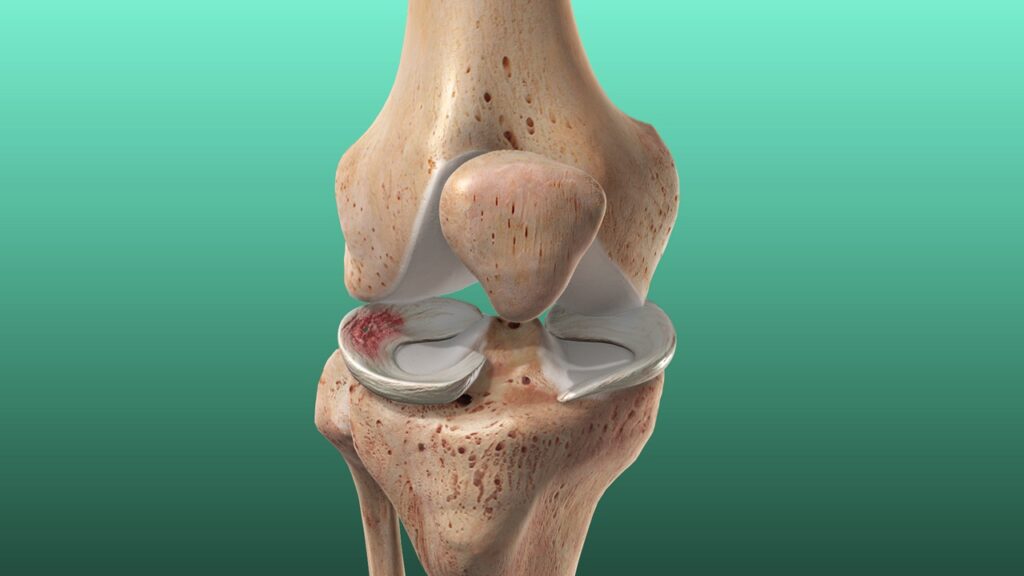Introduction:
Meniscal injuries are among the most common knee problems, affecting individuals of all ages and activity levels. These crucial structures play a important role in knee function and understanding their injuries is key to effective management and recovery.
- The menisci are two C- shaped, rubbery cartilage discs located within the knee joint-the medial (inner) and lateral (outer) meniscus.
- Tear of the medial meniscus is the commonest injury (nine times out of ten) due to its relative lack of mobility.
- The ratio of the anteroposterior displacement of medial and lateral meniscus is 1: 2 (Kapandji, 1970). It is produced by a sudden rotational force with the knee in semiflexed weight-bearing position.
Etiology:
Meniscal tear can be broadly categorized by their cause:
- Degenerative Tears: More prevalent in older adults, these tears occur due to the gradual wear and tear of the meniscus over time , even with minimal trauma.
- Traumatic Tears: Often seen in younger, active individuals, resulting from sudden pivots, twists or direct impact to the knee. Sports like basketball, football and soccer are common culprits.
Mechanism of Injury:
- Sudden twisting injury to the knee while the foot is in contact with the ground,
- A blow to the flexed and rotated extremity.
- Sudden movement from the hyper flexed to erect posture.
- Injury to the medial meniscus may cause concomitant injury to the medial collateral ligament and anterior cruciate ligament.
Signs & Symptoms:
Common indicators of a meniscal injury include:
- Pain: Often localized to the knee joint line, especially with squatting or twisting.
- Swelling: Swelling may be present around the knee joint.
- Clicking or popping Sensation: Stiffness Feeling of your knee giving way.
- Locking: Feeling as though your knee is locked in place when you try to move it.

Physiotherapy Management:
Physiotherapy plays a vital role in both conservative and post- surgical management of meniscal injuries. Key components include:
- Pain and Swelling Reduction: RICE is very important in the first 24 hours after an acute soft tissue injury. Especially when there are damaged blood vessels. It helps to reduce pain and swelling.
- Strengthening exercise: Physiotherapy is one example of conservative treatment; it focuses on strengthening of the quadriceps muscle to prevent secondary quadriceps atrophy.
- Range of motion exercise: Flexibility exercises and joint mobilization are techniques improve the range of motion and the flexibility.
- Proprioception and Balance Training: Balance and agility exercises begin with double-support weight-bearing activities and progress to single-limb static balancing on a stable surface.
- Activity of daily Living: After surgery, expect for your patient to be on crutches for at least three weeks. Full recovery, using a comprehensive rehabilitation program will generally take between 3-4 months, and athletes involved in high level sports can be back on the field around 6-8 months post-operative (always verify this with the surgeon, and the particular protocol you are following). This timeline does not take into account if other structures (e.g. the ACL), are also involved.
Risk Factors:
Possible risk factors for meniscal tears are sports, male sex, older age, and pre-existing pathologies such as osteoarthritis, ankylosing spondylosis. Additional risk factors are being overweight, reduced muscle strength, intensive training, varus or valgus deformity of the lower leg. Lesions in the meniscus can also increase the risk factor of developing knee osteoarthritis (OA).
Diet and Nutrition for Recovery
A balanced diet plays a supportive role in meniscal healing. Foods rich in omega-3 fatty acids (like fish and flaxseeds), vitamin C (found in citrus fruits), and collagen-boosting proteins help repair cartilage and reduce inflammation. Staying hydrated and maintaining a healthy weight also reduce pressure on the knee joint.
Conclusion:
Meniscal injuries, while common, can significantly enact knee function. The meniscus is quite often damaged by intensive sports like football, it often occurs due to a twisting injury on a semi-flexed limb through a weight bearing knee. The surgical approach to meniscal tears is typically determined by the type of the tear in conjunction with the tear location, patient age, and chronicity of the tear. Surgery isn’t necessary when meniscus teas are stable and relatively small and is located in a well-perused region. These can be treated with physical therapy.
Q1. What is a meniscal injury?
A1. A meniscal injury is a tear in the C-shaped cartilage (meniscus) of the knee, commonly caused by twisting or rotational forces during movement.
Q2. What are the common symptoms of a meniscal tear?
A2. Symptoms include knee pain, swelling, locking, stiffness, and a clicking or popping sensation.
Q3. How does physiotherapy help in meniscal injury management?
A3. Physiotherapy reduces pain and swelling, improves joint motion, strengthens muscles, and restores balance and functional movement.

